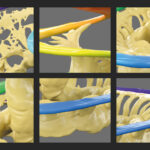
MED-EL
Published Oct 27, 2025
VIBRANT SOUNDBRIDGE & Stapes-SH-Coupler: Surgical Video With Prof. Farid Alzhrani
Today we are looking at an exciting case study from MED-EL’s comprehensive surgical video library. An 11-year-old with unilateral conductive hearing loss receives a VIBRANT SOUNDBRIDGE with a Stapes-SH-Coupler.

This VIBRANT SOUNDBRIDGE implantation surgery was filmed live with a high-resolution camera, making it possible to see all the steps in great detail. Audio commentary has also been added to the video by head surgeon Prof. Farid Alzhrani.
The implantation:
- Patient: 11 years old at time of operation
- Diagnosis: unilateral conductive hearing loss
- Received a VIBRANT SOUNDBRIDGE middle ear implant
- Transducer attached to the head of the stapes with a Stapes-SH-Coupler
Patient History and Preparation
As Prof. Alzhrani explains, the 11-year-old came to the King Abdullah Ear Specialist Center at the King Saud University Medical City in Riyadh after having significant trouble following what his teacher was saying in the classroom. About five years before, he had received a bone conduction hearing aid to treat the conductive hearing loss he had in his left ear due to congenital microtia and atresia. This treatment, however, turned out to be insufficient in school, especially when trying to understand speech in noise.
In addition to a comprehensive audiological exam, a CT scan including the ear canal, middle ear, and inner ear was performed at the clinic. Alzhrani discovered a malformation of the ossicular chain, and the ear canal was completely closed off due to ossification. He also established that the stapes was present but immobile.
Treatment Options for Conductive Hearing Loss Due to Microtia & Atresia
There are essentially three surgical treatment options, Prof. Alzhrani explained: canalplasty, a bone conduction implant, or an active middle ear implant (VIBRANT SOUNDBRIDGE).
In this case, canalplasty was not an option since there would have been a low chance of success for this particular patient. The importance of unilateral, ear-specific stimulation was key in Alzhrani’s decision to go with VIBRANT SOUNDBRIDGE rather than a bone conduction implant.
Choosing a solution that is effective on the affected side and leaves the other, completely normally functioning ear alone was a key concern for him as well as the patient and his parents.
Powerful, Ear-Specific Stimulation
In cases of mixed hearing loss with bone conduction thresholds greater than or equal to 35 dB HL, VIBRANT SOUNDBRIDGE delivers better hearing results than bone conduction implants.Mojallal, H., Schwab, B., Hinze, A. L., Giere, T., & Lenarz, T. (2015). Retrospective audiological analysis of bone conduction versus round window vibratory stimulation in patients with mixed hearing loss. International journal of audiology, 54(6), 391-400. https://doi.org/10.3109/14992027.2014.986690[1]
Why? VIBRANT SOUNDBRIDGE vibrates the ossicular chain directly. Above a certain level of vibration, bone conduction implants can generate feedback and crosstalk to the other ear, but VIBRANT SOUNDBRIDGE stimulates only the implanted ear.
This focused stimulation enables true binaural hearing, excellent sound localization,Agterberg, M. J., Straatman, L., Bruchhage, K. L., Jürgens, T., Hollfelder, D., & Leichtle, A. (2024). The merits of bilateral application of middle ear implants in patients with bilateral conductive and/or mixed hearing loss. Trends in Hearing, 28, https://doi.org/10.1177/23312165241264466[2] and great understanding of speech in noise.Mojallal, H., Schwab, B., Hinze, A. L., Giere, T., & Lenarz, T. (2015). Retrospective audiological analysis of bone conduction versus round window vibratory stimulation in patients with mixed hearing loss. International journal of audiology, 54(6), 391-400. https://doi.org/10.3109/14992027.2014.986690[1]Rahne, T., Fröhlich, L., Wagner, L., Kropp, M. H., & Müller, A. (2022). Speech perception and hearing effort using a new active middle ear implant audio processor. European Archives of Oto-Rhino-Laryngology, 279(10), 4667-4675. https://doi.org/10.1007/s00405-021-07207-4[3]
- Powerful, focused stimulation
- True binaural hearing
- No crosstalk
- No feedback
- No transcranial attenuation
- Natural sound quality
Interoperative Decision: Stapes-SH-Coupler
The preoperative CT scan did not make it clear whether the stapes would be suitable for attaching the transducer. For this reason, the decision about whether to choose the Stapes-SH-Coupler or the CliP-Coupler had to be made intraoperatively. After removing the malleus and the incus, the stapes was mobile enough to be suitable for the Stapes-SH-Coupler.
This coupler could be easily placed on to the stapes since intraoperative ABR measurements showed optimal processing of the vibrations.
Quick, Standardized Coupling for VIBRANT SOUNDBRIDGE
Fast coupling of the implant on the incus or the head of the stapes makes surgery simple.
For patients with an intact ossicular chain, the Incus-SP-Coupler is used to place the transducer (Floating Mass Transducer, FMT) on the short process of the incus. For patients with an interrupted ossicular chain, the FMT can be attached to the head of the stapes.
The wide variety of additional couplers offers maximum flexibility—they are suited to a variety of anatomical conditions and surgical preferences.
What You’ll See in the Video
The surgical video is split into the following chapters and surgical steps:
- Preparation:
- Planning with consideration of possible future ear reconstruction
- Incision:
- Opening of skin and periosteum; fixation of skin for clear view of the bone
- Access to the Middle Ear:
- Opening the facial recess; malleus and incus completely removed; ensuring there is enough space for the transducer (Floating Mass Transducer, FMT)
- Periosteal Pocket and Bone Bed:
- Drilling the implant bed (only the surface); skin flap thickness check
- Fixation of Implant:
- Implant placed and attached with self-drilling screws
- Attachment of Coupler to FMT:
- Stapes-SH-Coupler selected; FMT attached to the coupler
- FMT Placement:
- Positioning of the conductor link: coupler pressed gently onto the stapes
- ABR Measurements:
- Intraoperative objective brainstem audiometry with clear response at 100, 80, and 60 dB
- Closure:
- Covering of the mastoid; closure in three layers
More Surgical Videos: Register for Free for Full Access
The MED-EL Surgical Video Library offers complete surgical case studies by leading ENT surgeons. High-resolution videos show precise movements and detailed structures in incredible clarity. By registering for myMED-EL for free, you can receive full access to the MED-EL Surgical Video Library.
Subscribe
To read more articles about hearing implants, ear surgery, and audiology, subscribe to the MED-EL Professionals Blog and get regular updates directly to your inbox.
References
-
[1]
Mojallal, H., Schwab, B., Hinze, A. L., Giere, T., & Lenarz, T. (2015). Retrospective audiological analysis of bone conduction versus round window vibratory stimulation in patients with mixed hearing loss. International journal of audiology, 54(6), 391-400. https://doi.org/10.3109/14992027.2014.986690
-
[2]
Agterberg, M. J., Straatman, L., Bruchhage, K. L., Jürgens, T., Hollfelder, D., & Leichtle, A. (2024). The merits of bilateral application of middle ear implants in patients with bilateral conductive and/or mixed hearing loss. Trends in Hearing, 28, https://doi.org/10.1177/23312165241264466
-
[3]
Rahne, T., Fröhlich, L., Wagner, L., Kropp, M. H., & Müller, A. (2022). Speech perception and hearing effort using a new active middle ear implant audio processor. European Archives of Oto-Rhino-Laryngology, 279(10), 4667-4675. https://doi.org/10.1007/s00405-021-07207-4
References

MED-EL
Was this article helpful?
Thanks for your feedback.
Sign up for newsletter below for more.
Thanks for your feedback.
Please leave your message below.
CTA Form Success Message
Send us a message
Field is required
John Doe
Field is required
name@mail.com
Field is required
What do you think?
Der Inhalt dieser Webseite dient nur zur allgemeinen Information. Es werden keine medizinischen Ratschläge gegeben. Kontaktieren Sie bitte Ihren Arzt oder Hörspezialisten und lassen Sie sich dort beraten, welche Hörlösung in Ihrem Fall geeignet ist. Nicht alle der gezeigten Produkte, Produktfunktionen oder Indikationen sind in allen Ländern zugelassen bzw. verfügbar.
Alfredo Rafael Dell Aringa
October 28, 2025
implante coclear
MED-EL
October 29, 2025
Alfredo, thank you for your comment. In case you wish to learn more about MED-EL cochlear implants, you can view more information here: https://www.medel.com/hearing-solutions/cochlear-implants Kind Regards

MED-EL

MED-EL





Conversation
1 Comment